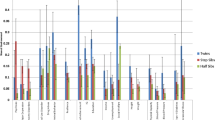Abstract
By extending a multivariate normal model for analyzing familial aggregation in a trait across arbitrary pedigrees, Hopper and Mathews [(1982).Ann. Hum. Genet. 46:373–383] showed that variations in correlations can be estimated as a function of cohabitation history. Such variations may result from the effect of shared environment, and the model allows for such an effect to cause dissimilarity in the trait values of individuals, perhaps through competition. Application to Cattell's Factor A, sizia (reserved, detached) versus affectia (outgoing, warm-hearted), measured on 597 individuals in 78 Melbourne families, reveals evidence for a small aggregating polygenic additive effect, corresponding to a “heritability” of 0.33. However, the traits of mothers and their juvenile offspring are significantly less correlated while cohabiting than would be predicted by this heritability. It is suggested that some other factor causes the dissimilarity, the effect of which appears to decrease as the time since cohabitation increases for adult mother-offspring pairs. We postulate that this disaggregating effect is the result of environmental factors related to cohabitation, although age- and sex-dependent effects of genetic factors cannot be excluded from providing an alternate explanation.
Similar content being viewed by others
References
Ahern, F. M., Johnson, R. C., Wilson, J. R., et al. (1982). Family resemblances in personality.Behav. Genet. 12:261–280.
Cattell, R. B. (1982).The Inheritance of Personality: Research Methods and Findings, Academic Press, New York.
Cattell, R. B., and Cattell, M. (1975).Handbook for the High School Personality Questionnaire, Institute for Personality and Ability Testing, Campaign, Ill.
Cattell, R. B., Eber, H. W., and Tatsuoka, M. (1970).Handbook for the Sixteen Personality Factor Questionnaire, Institute for Personality and Ability Testing, Champaign, Ill.
Cavalli-Sforza, L. L., and Feldman, M. W. (1981).Cultural Transmission and Evolution: A Quantitative Approach, Princeton University Press, Princeton, N.J.
Cloninger, C. R., Rice, J., and Reich, T. (1979a). Multifactorial inheritance with cultural transmission and assortative mating. II. A general model of combined polygenic and cultural inheritance.Am., J. Hum. Genet. 31:176–198.
Cloninger, C. R., Rice, J., and Reich, T. (1979b). Multifactorial inheritance with cultural transmission and assortative mating. III. Family, structure and the analysis of separation experiments.Am., J. Hum. Genet. 31:366–388.
Eaves, L. J. (1976). A model for sibling effects in manHeredity 36:205–214.
Eaves, L. J. (1977). Interring the causes of human variation.JRSS A140:324–355.
Eaves, L. J. (1978). Twins as a basis for the causal analysis of human personality In Nance, W. E. (ed.),Twin Research: Psychology and Methodology, Alan R. Liss, New York, pp. 151–174.
Eaves, L. J., and Eysenck, H. J. (1977). A genotype-environmental model for psychoticism.Adv. Behav. Res. Theor. 1:5–26.
Fisher, R. A. (1918). The correlation between relatives on the supposition of Mendelian inheritance.Trans. Roy. Soc. Edinb. 52:399–433.
Hopper, J. L., and Mathews, J. D. (1982). Extensions to multivariate normal models for pedigree analysis.Ann. Hum. Genet. 46:373–383.
Hopper, J. L., and Mathews, J. D. (1983). Extensions to multivariate normal models for pedigree analysis. II. Modeling the effect of shared environment in blood lead levels.Am. J. Epidemiol. 117:344–355.
Hopper, J. L., Balderas, A., and Mathews, J. D. (1982a). Analysis of variation in blood lead levels in Melbourne families.Med. J. Aust. 2:573–576.
Hopper, J. L., Tait, B. D., Propert, D. N., and Mathews, J. D. (1982b). Genetic analysis of systolic blood pressure in Melbourne families.Clin. Exp. Pharmacol. Physiol. 9:247–252.
Jöreskog, K. G. (1973). Analysis of covariance structures. In Krishaniah, P. R. (ed.),Multivariate Analysis III. Proceedings of the Third International Symposium on Multivariate Analysis, Academic Press, New York.
Lange, K., Westlake, J., and Spence, M. A. (1976). Extensions to pedigree analysis. III. Variance components by the scoring method.Ann. Hum. Genet. 39:485–491.
Martin, N. G., and Eaves, L. J. (1977). The genetical analysis of covariance structure.Heredity 38:77–95.
Mather, K., and Jinks, J. L. (1982).Biometrical Genetics: The Study of Continuous Variations, 3rd. ed., Chapman & Hall, London.
Mathews, J. D., and Hopper, J. L. (1983). Age-dependent means and variances of quantitative traits studied over pedigrees, Unpublished manuscript.
Rao, D. C., Morton, N. E., and Yee, S (1974). Analysis of family resemblance. II. A linear model for familial correlation.Am. J. Hum. Genet. 26:331–359.
Rao, D. C., MacLean, N. E., and Morton, N. E., (1975). Analysis of family resemblance. V. Height and weight in Northeastern Brazil.Am. J. Hum. Genet. 27:509–520.
Rao, D. C., Morton, N. E., and Cloninger, C. R. (1979). Path analysis under generalized assortative mating. I. Theory.Genet. Res. Camb. 33:175–188.
Rice, J., Cloninger, C. R., and Reich, T. (1980). General causal models for sex differences in the familial transmission of multifactorial traits: An application to human spatial visualising ability.Soc. Biol. 27:36–47.
Author information
Authors and Affiliations
Additional information
We are grateful to the Shepherd, Foundation and Sr. A. Balderas for help with data collection and Dr. J. D. Mathews for making the data available. This work was supported by the National Health and Medical Research Council of Australia, the U.S. Public, Health Service (HL 19984), and the Victor Hurley Fund of the Royal Melbourne Hospital.
Rights and permissions
About this article
Cite this article
Hopper, J.L., Culross, P.R. Covariation between family members as a function of cohabitation history. Behav Genet 13, 459–471 (1983). https://doi.org/10.1007/BF01065922
Received:
Accepted:
Issue Date:
DOI: https://doi.org/10.1007/BF01065922




